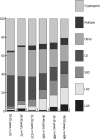Risk Factors and Causes of Ischemic Stroke in 1322 Young Adults
- PMID: 36511150
- PMCID: PMC9855752
- DOI: 10.1161/STROKEAHA.122.040524
Risk Factors and Causes of Ischemic Stroke in 1322 Young Adults
Abstract
Background: Identification of risk factors and causes of stroke is key to optimize treatment and prevent recurrence. Up to one-third of young patients with stroke have a cryptogenic stroke according to current classification systems (Trial of ORG 10172 in Acute Stroke Treatment [TOAST] and atherosclerosis, small vessel disease, cardiac pathology, other causes, dissection [ASCOD]). The aim was to identify risk factors and leads for (new) causes of cryptogenic ischemic stroke in young adults, using the pediatric classification system from the IPSS study (International Pediatric Stroke Study).
Methods: This is a multicenter prospective cohort study conducted in 17 hospitals in the Netherlands, consisting of 1322 patients aged 18 to 49 years with first-ever, imaging confirmed, ischemic stroke between 2013 and 2021. The main outcome was distribution of risk factors according to IPSS classification in patients with cryptogenic and noncryptogenic stroke according to the TOAST and ASCOD classification.
Results: The median age was 44.2 years, and 697 (52.7%) were men. Of these 1322 patients, 333 (25.2%) had a cryptogenic stroke according to the TOAST classification. Additional classification using the ASCOD criteria reduced the number patients with cryptogenic stroke from 333 to 260 (19.7%). When risk factors according to the IPSS were taken into account, the number of patients with no potential cause or risk factor for stroke reduced to 10 (0.8%).
Conclusions: Among young adults aged 18 to 49 years with a cryptogenic ischemic stroke according to the TOAST classification, risk factors for stroke are highly prevalent. Using a pediatric classification system provides new leads for the possible causes in cryptogenic stroke, and could potentially lead to more tailored treatment for young individuals with stroke.
Keywords: Netherlands; atherosclerosis; ischemic stroke; prognosis; risk factors.
Figures

References
-
- Ekker MS, Verhoeven JI, Vaartjes I, van Nieuwenhuizen KM, Klijn CJM, de Leeuw FE. Stroke incidence in young adults according to age, subtype, sex, and time trends. Neurology. 2019;92:e2444–e2454. doi: 10.1212/WNL.0000000000007533 - PubMed
-
- Feigin VL, Roth GA, Naghavi M, Parmar P, Krishnamurthi R, Chugh S, Mensah GA, Norrving B, Shiue I, Ng M, et al. ; Global Burden of Diseases, Injuries and Risk Factors Study 2013 and Stroke Experts Writing Group. Global burden of stroke and risk factors in 188 countries, during 1990–2013: a systematic analysis for the global burden of disease study 2013. Lancet Neurol. 2016;15:913–924. doi: 10.1016/S1474-4422(16)30073-4 - PubMed
-
- Jacob MA, Ekker MS, Allach Y, Cai M, Aarnio K, Arauz A, Arnold M, Bae HJ, Bandeo L, Barboza MA, et al. . Global differences in risk factors, etiology, and outcome of ischemic stroke in young adults—a worldwide meta-analysis: the GOAL initiative. Neurology. 2022;98:e573–e588. doi: 10.1212/WNL.0000000000013195 - PMC - PubMed
-
- Maaijwee NA, Rutten-Jacobs LC, Arntz RM, Schaapsmeerders P, Schoonderwaldt HC, van Dijk EJ, de Leeuw FE. Long-term increased risk of unemployment after young stroke: a long-term follow-up study. Neurology. 2014;83:1132–1138. doi: 10.1212/WNL.0000000000000817 - PubMed
-
- Putaala J, Metso AJ, Metso TM, Konkola N, Kraemer Y, Haapaniemi E, Kaste M, Tatlisumak T. Analysis of 1008 consecutive patients aged 15 to 49 with first-ever ischemic stroke: the Helsinki young stroke registry. Stroke. 2009;40:1195–1203. doi: 10.1161/STROKEAHA.108.529883 - PubMed
Publication types
MeSH terms
LinkOut - more resources
Full Text Sources
Medical

